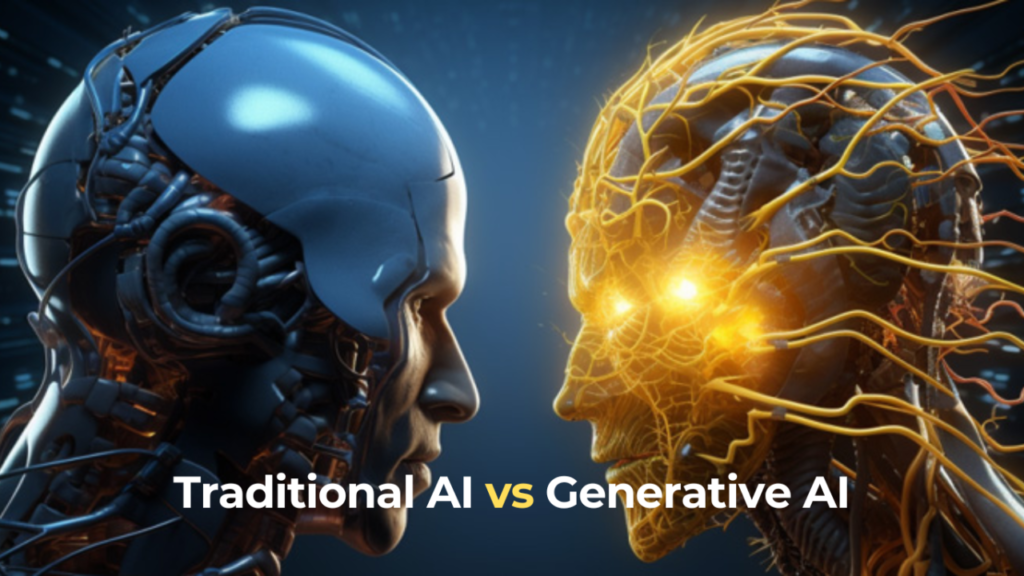Artificial Intelligence (AI) has been the most popular phrase in all industries because of its amazing characteristics and advantages. Based on useful data insights, AI improves operational efficiency and aids in organizational decision-making. But as we learn more about AI, we need to recognize and understand its various manifestations. There are two types of artificial intelligence (AI) technology, and it’s critical to understand both traditional and generative AI. Popularity of the latter one can be known from the fact that more than 1000 generative AI development company have emerged in the last few years.
What are generative AI and traditional AI? What distinguishes them from one another? This blog aims to address this question.
What Is Traditional AI?
A kind of artificial intelligence known as traditional AI—also called narrow or weak AI—is employed to carry out tasks according to preset algorithms. Compared to other forms of AI, traditional AI-based solutions are typically better at completing a smaller range of tasks and have a more constrained range of possible uses.
Chatbots, self-driving cars, and chess-playing algorithms are a few instances of traditional AI.
Characteristics of Traditional AI
Traditional AI’s primary attributes are as follows:
Programmed intelligence: Conventional AI relies on pre-established rules and algorithms. The system works within the constraints of the algorithm that programmers created to offer answers and complete tasks.
Limited applications: The range of possible uses for these AI models is constrained because they were created with a certain set of tasks in mind.
Data analysis: The main goal of traditional AI is to examine data sets and generate predictions from them. Forecasting and other data analysis can be done with it with success.
Limited learning skills: Traditional AI’s learning capabilities are constrained and rely on data sets that are entered by the human creator.
What Is Generative AI?
To create content, make judgments, or resolve issues, leading artificial intelligence development companies bring on generative AI which uses probabilistic modeling and data-driven learning. Generative AI, in contrast to traditional AI, learns patterns and structures from enormous volumes of data rather than depending on explicit rules.
Neural networks—more especially, deep learning models—are one of the most important developments in generative artificial intelligence. These models, like Recurrent Neural Networks (RNNs) and Generative Adversarial Networks (GANs), have proven to be exceptionally adept at producing realistic text, images, and even music.
Characteristics of Generative AI
Some of the most important characteristics of generative AI are:
Neural network generators: To produce pertinent and unique output, generative AI makes use of neural networks such as GANs and VAEs.
Diverse applications: These AI models can provide a variety of content since they are flexible and adaptable. Applications for them are numerous and span many different industries.
Using prompts to produce new content: Generative AI does more than just analyze data; it also uses prompts and data to create new content. The result is distinct and pertinent to the prompt from which it was generated.
Traditional AI vs Generative AI – The Key Differences
Below are the key distinctions between generative and traditional artificial intelligence-
Focus and Output
Traditional AI: It has a narrow range of applications. To find patterns, generate predictions, and carry out particular tasks, the model analyzes data. It solves problems quite effectively.
Generative AI: It uses data analysis and human input to produce unique data. One way to think of this AI is as a creative helper.
Applications
Traditional AI: Frequently employed in applications such as recommendation systems, fraud detection, and spam filtering.
Generative AI: Used in the production of images, music, and other types of material.
Transparency
Traditional AI: Its decision-making process is more visible and interpretable because it frequently follows predetermined rules.
Generative AI: Because of the complexity of its learning algorithms, generative AI may be less visible, making it difficult to understand how it produces particular results.
All things considered, generative AI accomplishes something that traditional AI cannot: it produces new media, opening up a wider range of possible applications and transforming numerous sectors. Traditional AI is well-suited for data processing and interpretation.
Final Thoughts
In conclusion, there are no obvious winners when comparing generative AI to traditional AI, often referred to as narrow or weak. We still depend on traditional AI to carry out specific analyses and predictions, even if it might seem less flexible and limited to particular tasks. Enrolling in Gen AI Training can provide a deeper understanding of how these two forms of AI complement each other.
Although generative AI gives us more options, its uses differ from those of traditional AI. The former is used to produce material that affects a variety of businesses, such as marketing, e-commerce, and entertainment. About problem-solving, pattern-based prediction, and producing novel output, generative and traditional AI will probably be utilized in collaboration in the future.
Caroline is doing her graduation in IT from the University of South California but keens to work as a freelance blogger. She loves to write on the latest information about IoT, technology, and business. She has innovative ideas and shares her experience with her readers.




![‘Jay Kelly’ Review – Noah Baumbach Makes A Case For The Magic Of Movie Stardom [NYFF 2025] ‘Jay Kelly’ Review – Noah Baumbach Makes A Case For The Magic Of Movie Stardom [NYFF 2025]](https://cdn.geekvibesnation.com/wp-media-folder-geek-vibes-nation/wp-content/uploads/2025/11/Jay-Kelly-JKELLY_20240523_15320_C2_R-300x180.jpg)

